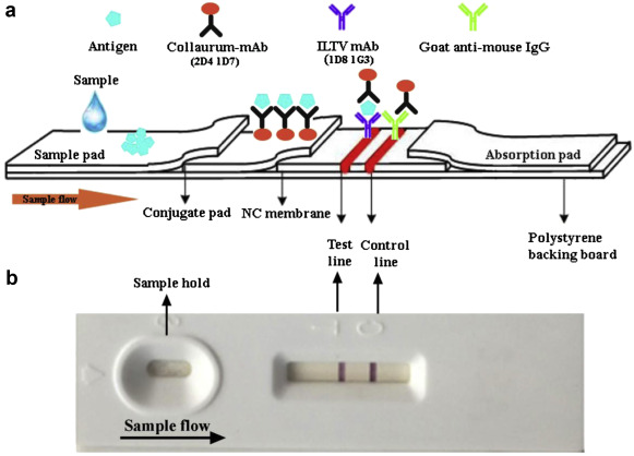Immune colloidal gold technique is a new type of immunolabeling technique that uses colloidal gold as a tracer marker applied to antigen and antibody, abbreviated as GICT. colloidal gold is composed of chloroauric acid (HAuCl4) polymerized into gold particles of specific size under the action of reducing agents such as white phosphorus, ascorbic acid, sodium citrate, tannic acid, etc., and becomes a stable colloidal state due to the electrostatic effect. The electrostatic effect becomes a stable colloidal state, called colloidal gold.
Colloidal gold assay principle The specific antibody is fixed on the membrane in the form of a strip (T-line), and the colloidal gold labeling reagent is adsorbed on the binding pad (gold pad). When the antigen to be detected is added to the sample pad at one end of the test strip, the sample moves forward through capillary action, dissolves the colloidal gold labeling reagent on the binding pad and reacts with each other, and then moves to the area of the fixed antigen or antibody, and the binding material of the antigen to be detected and the gold labeling reagent is specifically combined with it and is retained, and gathered on the detection strip, and the coloring result can be observed by the naked eye.

Advantages of use
(1) Easy and fast to use, convenient for grassroots use and field use, all reactions can be completed within 15 minutes.
(2) Low cost, no special instruments and equipment required.
(3) Wide range of applications, can be adapted to a variety of testing conditions.
(4) Multiple assays can be performed, and if positive samples are difficult to obtain, multiple assays can save samples and reduce costs.
(5) Stable markers, labeled samples stored at 4 ℃ for more than two years, no signal attenuation phenomenon.
(6) Colloidal gold itself is red, no need to add coloring reagents, eliminating the step of carcinogenic substrate and termination solution for enzyme labeling, non-toxic to humans.
Composition of colloidal gold test strips
Colloidal gold test strips are mainly composed of 4 parts: sample pad, gold pad, nitrocellulose membrane (NC membrane) and absorbent paper, which are connected to each other from top to bottom and pasted on the PVC backing board.
Function
a. Sample pad: test sample drip position, the test sample has a certain filtering and buffering effect, reduce the sample ionic strength or acidity interference with the test results.
b. Gold pad: the colloidal gold-labeled antibody is fixed on the glass cellulose membrane by drying, is to track the reaction between the antibody and the antigen. c. Nitrocellulose membrane: the membrane is pre-encapsulated with detection line and quality control line, which can combine with colloidal gold marker immunoreactivity, so that colloidal gold in the detection line aggregation occurs, and the results are interpreted according to the color development status of the detection line.
c. Absorbent pad: the liquid sample flows upward through the action of water absorption, driving the gold labeled antibody of the gold pad to move upward, thus reacting with the antigen of the detection line.
The process of making colloidal gold test strips



